
Schistosomiasis
Tackling Schistosomiasis in Uganda
Neglected tropical diseases are a group of infections that are little known but affect more than a billion people worldwide. Now scientists at Glasgow have adopted an interdisciplinary approach to tackle one such infection, schistosomiasis, in an effort to control the disease and fill a critical global health knowledge gap.
Schistosomiasis is a disease caused by parasitic worms which infects 240 million people worldwide, many of whom live in sub-Saharan Africa. The disease is most common in poor rural areas where a lack of safe water and inadequate sanitation means people are reliant on water infected with the parasite for everyday use.
The disease causes anaemia, stunted growth and reduced cognitive development in infected children. Those exposed to long-term infection can experience liver damage and kidney failure amongst other symptoms. As many as 200 thousand people die from schistosomiasis every year. It is classified as a neglected tropical disease despite its socio-economic impact being second only to malaria amongst parasites.
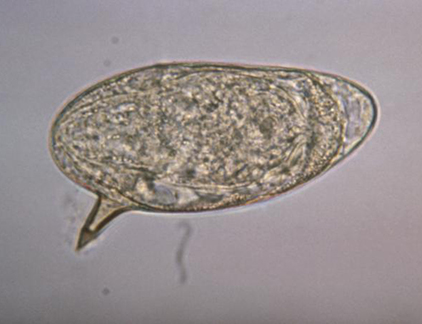
Schistosomiasis parasite egg
Mass Drug Administration
For the past ten years, Mass Drug Administration (MDA) has been implemented in several countries in sub-Saharan Africa in a bid to stamp out the disease. This involves administering the drug praziquantel to school-age children in low and moderately affected areas and to all people over 5 years old in heavily affected areas as part of large-scale national control programmes. Though this has been successful in some areas with reductions in morbidity and transmission, the disease remains a serious public health issue in many other places.
Now a multi-disciplinary team of scientists led by Dr Poppy Lamberton from the Institute of Biodiversity, Animal Heath & Comparative Medicine are tackling the schistosomiasis threat with a host of novel approaches and new technologies.
Research aims
With €1.5 million funding from the European Research Council, one of the aims of the Lamberton lab is to evaluate the impact of the MDA programmes and identify potential threats. Longitudinal data from three villages in Uganda revealed that the praziquantel drug campaign had failed to work in these communities. Over a ten-year period, children had become more heavily infected and the associated morbidity was worse. Our researchers are using a number of methodologies to find out why this is.
On one level, the team are seeking to find out more about the biology of the parasite in order to reduce transmission within the community. The disease has a complex lifecycle involving two hosts. People become infected when parasitic larvae, released by freshwater snails, penetrate the skin during contact with infected water. Once in the human host, adult worms develop in the intestine where they mate and produce eggs, which are excreted in the urine or faeces. If the eggs are excreted into freshwater they then hatch and infect intermediate snail hosts. In the snail, the eggs multiply and produce larvae, which are released into the water, and the lifecycle repeats again.
The complexity of this lifecycle makes it difficult to deduce who is infecting whom in the community as direct-contact tracing is impossible. So our researchers are employing parasite genetics through looking at the larvae, hatched from eggs in stool, to attribute where the parasite is coming from and treat those most heavily infected to stop them spreading the infection further, as Dr Lamberton explains:
“Unfortunately there isn't enough of the drug to treat everyone, so we have to prioritise treatment. We look at parasite genetics to find out if the parasites causing children to get rapidly re-infected are similar to those in other children, or perhaps fishermen, or pre-school children who haven't been treated. Once we know who these drivers of re-infection are, we can work out who to treat first."
Our scientists are also analysing the effectiveness of the drug. For some people, the infection is not cleared with praziquantel treatment and it is unclear why. The team are therefore using immunology and pharmacokinetics methods to measure drug absorption levels alongside drug efficacy monitoring methods. This is to discover whether the parasites are resistant to the drug, or if some people are resistant to the parasites, or only absorb small amounts of the drug or whether there is some other host factor at work. They are also researching schistosome-microbiome drug interactions as there is evidence that gut bacteria diversity is linked to drug absorption.
In addition to this parasitological research, Dr Lamberton received £423,130 from the MRC Global Challenges Research Fund to better understand people's behaviour towards the disease and help them to change it. As part of this, Dr Lamberton's team, which comprises several Ugandan anthropologists, are conducting rapid ethnographic appraisals, which includes interviews, focus groups and observation studies in the villages to glean knowledge about what the local community perceive schistosomiasis to be and how they manage their own risk.
"What we're trying to do is find local interventions that are affordable and popular, because this means they're more likely to be sustainable ," explains Dr Lamberton. "If we can find these successful local interventions, we can then expand them to a community level."
For example, though pit latrines may seem like a logical solution for preventing open defecation and subsequently the spread of the disease, a survey of the local population has revealed obstacles which prevent the community using them, such as a lack of shoes and a fear of children falling in. Therefore, only through carrying out ethnographic research can the team discover which solutions are truly practical and sustainable for the community.
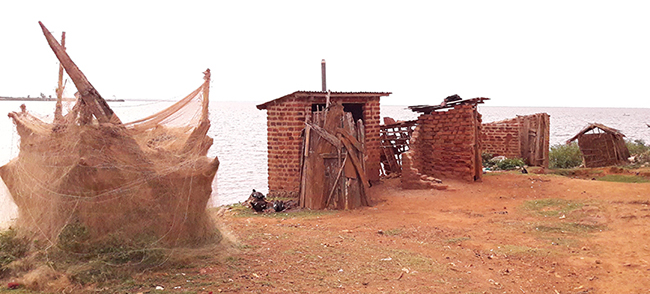
Pit latrines on the shores of Lake Victoria, Uganda
Using this information with engineers from the University of Glasgow, Dr Lamberton’s group is also looking for novel local engineering sanitation solutions. An economist is also about to join the group to see what sort of behavioural nudges might be needed to persuade people to use current and improved water and sanitation infrastructure. The anthropology work is also being combined with parasite genetics to understand where heavily infected children are getting re-infected from, and if uninfected children really don’t come into contact with the water and might be resistant in some way to schistosomiasis infections.
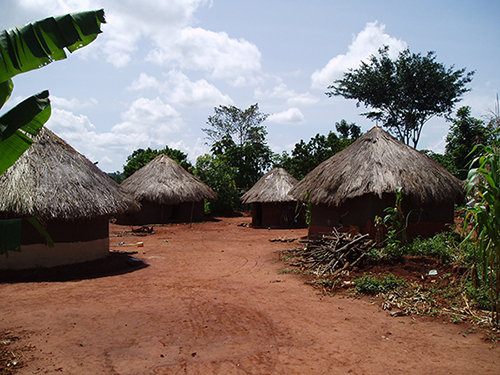
Musubi village, Uganda
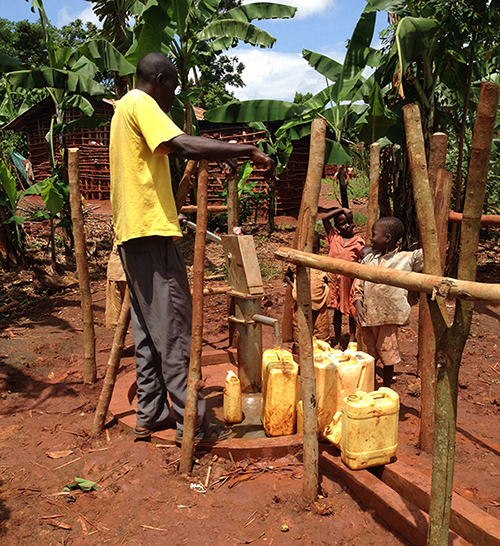
Village water source
Findings
Data from this anthropological and parasitological research combined has already revealed some significant findings. Through surveying the entire community of around 3,000 people in the village of Bugoto, the researchers learned that a huge proportion of the population, around 25 to 50% of people above school age, had in fact never been treated with praziquantel. This statistic is surprising considering a control programme has been in place in the village for over a decade. Reasons for this included community members being away on treatment day, assuming the drug was only for children or having never heard about the free drug treatment. Those that were away were often the strongest drivers of re-infection, for instance fishermen who were some of the most heavily infected as a result of being in constant contact with infected water. These anthropological methods therefore highlight the importance of effective organisation of MDA campaigns to ensure that everyone eligible for treatment receives it.
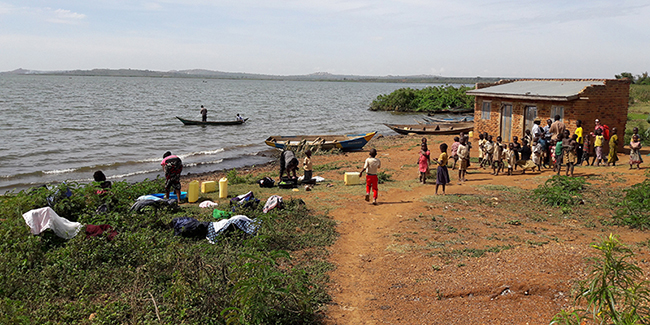
Schistosomiasis transmission site in Bugoto, Uganda
The team are also carrying out a long-term diagnostic study which has revealed that re-infection after treatment can happen very quickly. They have found that people can start producing eggs from the parasite just six weeks post-treatment. After six months the number of eggs can have returned to the original level, so drug treatment on an annual basis may not be enough. This six-month study is developing our understanding of the effect that the drug has on the parasites and is helping to differentiate between rapid reinfection and worms surviving treatment.
These findings underline the idea that to successfully combat schistosomiasis in high endemicity areas, a sociological approach needs to be adopted in tandem with MDA, something Dr Lamberton has long advocated:
"A lot of neglected tropical diseases, such as soil-transmitted helminths and elephantiasis, have been controlled with mass drug administration. That's been the mainstay and it's been really successful for a lot of them. But schistosomiasis is really unusual in that it's more like malaria, in that it reproduces and amplifies in number outside of the human host. So a small number of us in the community have been saying you can't treat it like all the rest. But that's starting to be better understood; so water, sanitation and hygiene are just as important as drug administration."

Fishing boats on Lake Victoria, Uganda
Interdisciplinary research at Glasgow
Though the research is ongoing, the key to the success of the research carried out by the Lamberton lab so far is its interdisciplinary nature. Only by combining fields as varied as parasite genetics, immunology, anthropology and engineering can a complex disease like schistosomiasis be effectively tackled. The University of Glasgow is committed to bringing expertise together from across the academic disciplines in order to find innovative approaches to fight neglected tropical diseases such as this, as Dr Lamberton confirms:
"Glasgow is incredibly supportive of interdisciplinarity. There is a diverse base of researchers working here, but there is a lot of overlap on technique which makes for a highly effective and motivating work environment."
The results of Dr Lamberton and her team’s research will improve monitoring of schistosomiasis and overall MDA effectiveness. The findings will also provide sustainable long-term intervention strategies to reduce transmission and re-infection, in turn bringing us closer towards elimination of the disease.
Funders:
- Engineering and Physical Sciences Research Council
- European Research Council
- MRC Global Challenges Research Fund
- Wellcome Trust
Discover more:

